Quick care stats of Daisy’s Ricefish – tank setup, tankmate, feeding
- Scientific name: Oryzias woworae
- Common name: Daisy’s Ricefish, Daisy’s Blue Ricefish, Ricefish
- Origin: Asia (Southeast Sulawesi, Indonesia)
- Max length: 1.0 – 1.2 inches
- Minimum tank size: 10 gallons
- Stocking: 8-10 fish for 10 gallons
- Temperament: very peaceful, schooling
- Feeding: Omnivore, accept dried foods, and live foods, algae
- Breeding: Quite easy
- Habitat: leaf-littered streams, with overhanging trees
- Hangs out: mid to top regions of the tank
- Care level: easy, with some restrictions
- Tank setup: a sandy substrate with driftwood and dried leaves or densely planted
- Temperature: 73.4 – 80.6°F
- pH: 6 – 7.5
- Water hardness (dGH): 5 – 15
- Lifespan: 3 – 4 years
- Appearances, temperament, and interesting facts
- Tank setup, layout, and stocking
- Tankmates for Daisy's Ricefish
- Diet, foods, and feeding
- Sex and breeding
Appearances, temperament, and interesting facts
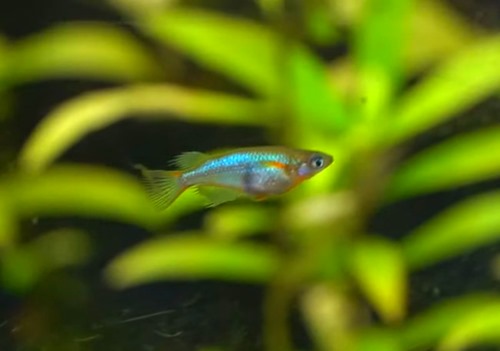
Oryzias woworae, were first discovered and collected by Dr. Daisy Wowor in 2007, then introduced to the aquatic world in 2010. This fairly recent addition to the hobby is something out of the ordinary and makes a beautiful addition to any peaceful, community tank.
Daisy’s ricefish are listed as an intermediate to hard fish to care for but we would classify them as easy, for the savvy beginner. Ours were special ordered and came in with a case of ich (which went unnoticed while they were in the bag). Long story short, the fish suffered the trauma of shipping, then being immediately dunked into a salt bath, and came through like troopers. We did not lose a single fish.
They do require very clean water, and appropriately sized food for their mouths, but other than that, they are quite hardy. As for personalities, they do care a bit about what goes on around them and will interact to a degree, but mostly it’s because they’re hungry.
They are nonaggressive towards tankmates, but sometimes, if spawning, the males will chase other male ricefish away (this does not happen all of the time).
Tank setup, layout, and stocking
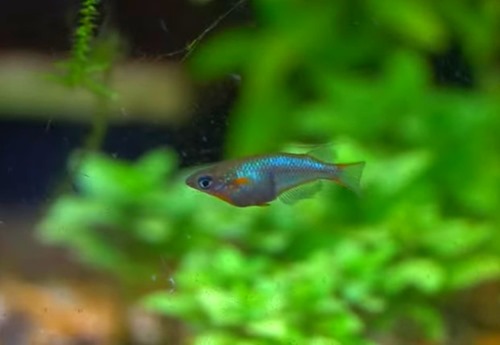
These fish don’t require anything special, but they do look better with at least some sort of decorations around them. In a bare tank, they’re sort of drab and washed out.
Ricefish, really shine in the planted aquarium, but if you’re more into biotopes and natural type settings, then you could use roots and/or branches, some rocks, and leaf litter, scattered over a sandy substrate.
Most sources list this fish as growing to an inch, or just over. Ours are more in the 2-inch range – almost the exact same size as the furcatus rainbows. Tank size should be a minimum of 10 gallons. They’re loosely schooling fish and should be kept in groups of at least 6.
Tankmates for Daisy’s Ricefish
Our ricefish are housed with rainbowfish (gertrudae, furcatus), celestial pearl danios, peacock gobies, and otocinclus. Some other suggestions are pygmy cories, shrimp (Amano, cherry, red rili, etc.), Sundadanio axelrodi, small tetras, and kubotai rasbora.
Whatever you choose, they should be peaceful and nonaggressive. While not as hyper as the furcatus rainbows, ricefish are active fish and some of their shenanigans might disturb those who like calmer waters (especially if they occupy the same areas of the tank). We have noticed that our ricefish will school with just about anything (especially the rainbows).
Diet, foods, and feeding
Ricefish are not fussy eaters, they willingly accept flakes as well as other commercial dried foods. However, they should be fed a varied diet that includes both live and frozen foods. Ricefish will find and eat algae in the aquarium.
If you want to breed this fish and have healthy fry, we would highly recommend using live food such as Daphnia, white worms, micro worms, baby brine shrimp, fruit flies, Grindal worms, e.g.
Sex and breeding
Males are more colorful and slimmer than females. Their dorsal and anal fins are longer than the females, too. During spawning, the males turn sort of gunmetal, gray seriously darker than their normal colors. They are prolific and very easy to breed.
Females spawn every few days with 10-20 eggs each time. They usually spawn in the morning. After spawning, the female carries the adhesive eggs attached to her vent for several hours. Eventually, the eggs get rubbed off onto plants, moss, and whatever you have in the tank.
Our ricefish are in a community tank, and if the female is carrying eggs, all the other fish follow her around like she’s their very own, personal, caviar vending machine. We do have fry hatch out every so often, but if we see a baby, we remove them from the tank and put them in a breeder box.
If you want fry for sure, then the parents need to be in a breeding tank of their own with some plants. You’ll need to remove the parents after spawning as they will eat both eggs and fry. The eggs, if given half of a chance, are quite easy to hatch within 1-3 weeks, depending on the water temperature.



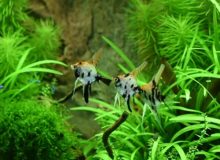
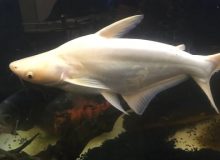
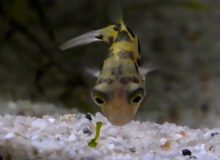
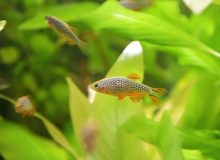
Leave a Reply